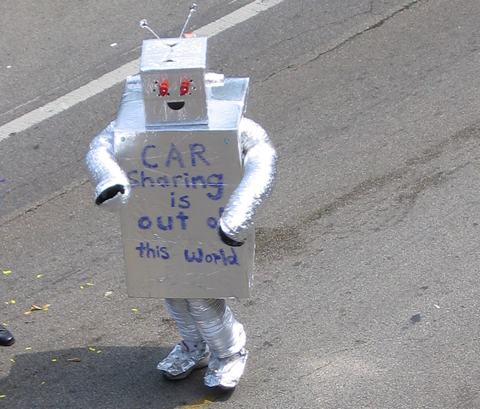Car sharing is not only a good idea; it’s a ridiculously smart use of resources. Car owners generally pay between $3000 and $10,000 per year to own a car that sits and takes up space for 22 to 23 hours per day. Car sharing programs like Zip Car and City Car Share have helped to take thousands of vehicles off the road, by giving drivers a viable alternative to car ownership. But for those of us that aren’t ready to give up our own cars, the question then becomes: how do we share our own cars?
On January 1, California enacted a law that creates a new way for Californians to share cars. It’s a great opportunity for people who have cars, people who need cars, and entrepreneurs who want to help other people share cars! I’ll explain below how to take advantage of that new law.
But no matter where you live, it’s still possible to share your car. And here is a little info on how to set it up legally:
The Legal Nitty Gritty: How to Share a Car
Let’s say you have a car you really only use on weekends and evenings, and you have a couple of neighbors who may be interested in using your car during the day. Unfortunately, your insurance company is going to make it a little bit challenging to share with those neighbors. Typically, you can’t add other drivers to your car insurance unless they live in your household or unless they are on title to the vehicle. Beyond that, insurance policies usually let other people drive your car occasionally. If someone else is driving your car regularly, your insurance company may decline to cover the other person’s accident, arguing that the policy does not cover other regular drivers. If another driver uses your car only occasionally, but pays you for the use of your car, your insurance company may again decline coverage, arguing that you are operating a car rental business, a use not covered by your policy.
Given these limitations, I generally advise clients to do one or some of the following if they want to share their car:
- Get permission from your insurance company: Get your insurance company’s permission in writing. Explain to them the situation, such as “my neighbor will borrow my car every Saturday to drive to her photography class.” Although that sounds like a “regular” use, your insurance company might say that it’s fine and covered under the provision for occasional drivers. If they approve, you’ll have it in writing in the event of an accident.
- Put the other drivers on title: If you plan to regularly share your car with someone who does not live at your address, put the other person on title to the vehicle and sign an agreement with them providing that you will take them off title at a later date. Once they are on title, the insurance company will be willing to insure both of you.
- Keep it casual and occasional: Allow people to use your car only occasionally and don’t enter into an agreement to have them pay you. Maybe casually ask that they fill up your gas tank when they use the car. Or casually hope they do something nice in return, which most people will, especially if they want to keep borrowing your car.
- Get “driver’s insurance” for the other drivers: Have the other driver purchase a “driver’s insurance” policy, which is liability coverage that kicks in if the primary insurance refuses coverage. It won’t cover damage to the vehicle, but it covers the really expensive stuff, like bodily injury.
For more information and a sample agreement for sharing your car, read Chapter 10 of The Sharing Solution: How to Save Money, Simplify Your Life & Build Community
AB 1871 Provides a New Pathway to Car Sharing in California
California’s AB 1871 went into effect January 1. This creative law gives us a new way around the insurance conundrum, by creating a framework whereby you can regularly let people use your car and earn money. However, this is key: you can’t earn a profit. The money you earn from sharing your car cannot amount to more than it costs for you to own your car. Also, if you want to share your car, you have to make the car part of a Personal Vehicle Sharing Program (PVSP) that facilitates the car sharing and will keep track of who drives your car, when, and where. Most importantly, the PVSP provides the insurance while other people are driving your car. That way, your primary vehicle insurance does not have to cover the other people who drive your car. The text of the law is fairly short, and you can read it here.
You can take advantage of this in at least two ways:
- Join a PVSP, also called a peer-to-peer carsharing company, such as start-ups Getaround, Spride, and Relay Rides. Once these companies are fully launched and have a critical mass of users, this could be the easiest way to take advantage of the new law.
- Start your own small PVSP! California’s new law has opened the door for many people to create PVSPs. While it’s possible that one of the existing start-up companies could quickly grow to dominate the market, I believe there are many niches where a small and local PVSP makes sense. For example, a small PVSP would fit perfectly in condo community, apartment complex, or retirement community, where people are more likely to know and trust each other. A PVSP could also have an edge if it focuses on a particular type of vehicle, like pick-up trucks or VW buses.

Photo by Rick Aiello on Flickr
Instructions for Starting a Car Sharing Program!
Here are instructions for forming a simple PVSP, taking into account the minimal legal requirements provided by AB 1871:
- Form an entity: First, the law requires you to create a legal entity for the PVSP, such as a cooperative corporation, limited liability company (LLC), or nonprofit corporation. In CA, this usually costs $800 a year in minimum taxes. However, there are at least two ways to avoid that annual $800: a) operate the PVSP under an existing entity, such as an existing business or your homeowners association, if allowed, or b) form as a nonprofit and obtain tax-exemption. Obtaining tax-exemption for a car sharing program can be very tricky, but it’s possible under certain circumstances. City Car Share in San Francisco is tax-exempt under 501(c)3, for example.
- Get members: Find an initial pool of members – both people who will make their vehicles part of the pool and people who will use the vehicles.
- Get insurance: Get insurance and put proof of that insurance in every shared vehicle. It’s hard to know how much insurance will cost, but I would estimate between $100 and $300 per month per vehicle, depending on how often it is used, who uses it, what the users’ driving records are, etc. The law requires that you get at least triple the minimum of legally required liability coverage, which is still not much. The minimum for bodily injury is $15,000, and I usually recommend getting a MUCH higher limit to make sure everyone is covered.
- Get your systems in place: Create a solid system for keeping track of who uses what vehicles, when, how many miles are driven, and where the car is parked initially and at the end of each trip. Also be ready to make all records available to insurance providers if requested. One more thing: the new law says this information must be maintained in “verifyable electronic records.” I’m really not sure what that means, and the law doesn’t explain it. Some of the peer-to-peer car sharing companies are developing advanced systems for tracking the use and location of the vehicle electronically using GPS. However, it may be legally sufficient to have people self-report where and when they drove the vehicle by logging on to a Google Doc, for example.
-
A few more things:
a. No Profits to Car Owners: You will also need to come up with a system to determine the cost of ownership for each car, and a way to ensure that the car owners aren’t earning more money that it costs them to own the vehicle.
b. No Motorcycles and Scooters: Sorry bikers, this law only applies to passenger vehicles with four wheels.
c. No Commercial Use: AB 1871 says that the vehicles shouldn’t be put to “commercial use.” It would be a separate and interesting research project to find out what that means. If anyone feels like researching it, please post info in the Comments section, below. Operating an airport shuttle service is definitely a “commercial use,” but what about driving to the office supply store to pick up stuff for your business? Is that a “commercial use?”
d. Lock and Ignition Systems: Although not legally required, you’ll probably also want to install numerical lock and ignition systems in the cars, which I’ve heard can cost around $700. If that’s too expensive, you can just install a numerical lock box near where the car is usually parked.
If you don’t live in California, and want to get a car sharing law passed in your state, please read next week's follow-up article, "Car Sharing Laws for Everyone."









